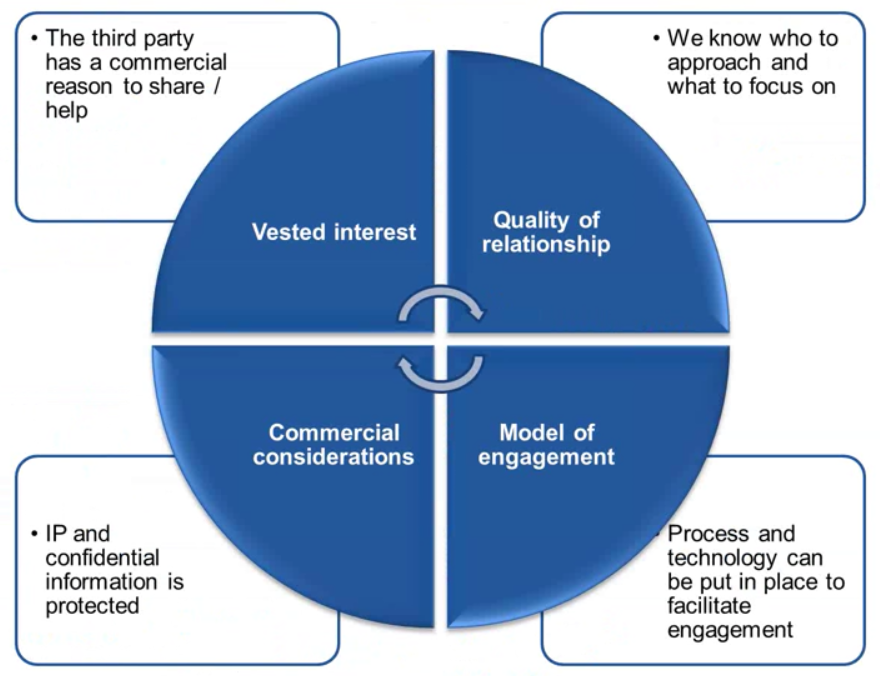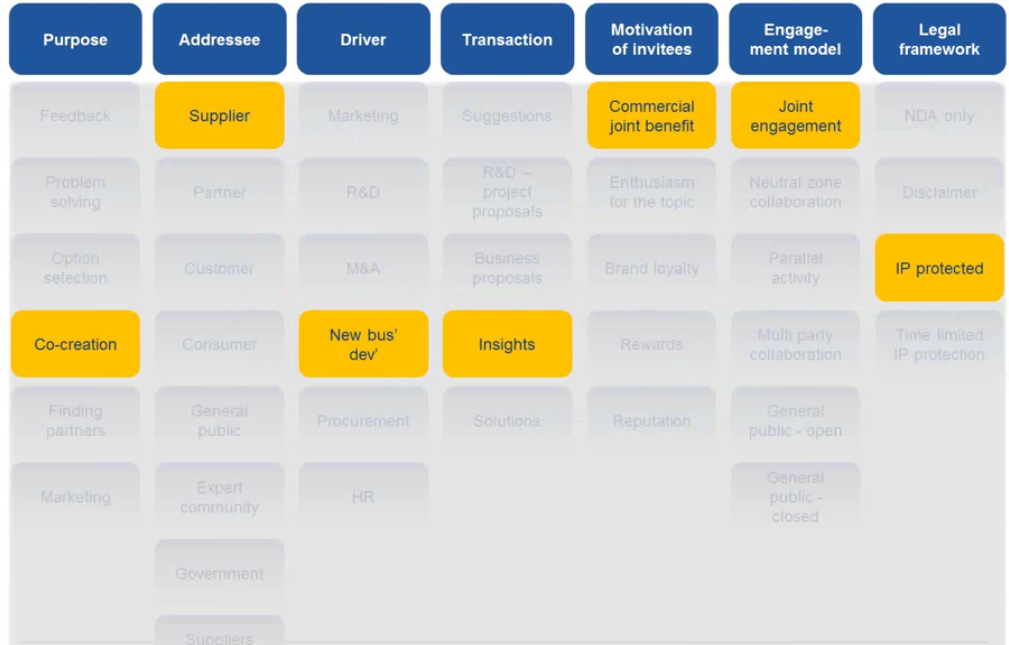The co-creation process as a form of open innovation can seem challenging for any company. However, it can create great opportunities for businesses to meet and exceed their customers’ expectations and gain a competitive advantage. And in today’s environment of rapid digital transformation, co-creation is a valuable component of many organizations’ innovation strategies.
But how do you get started and how can you make co-creation a sustainable part of your transformation strategy?
What is co-creation?
Co-creation is an open innovation model in which organizations include external audiences in their ideation and in the development process for new products or services. Co-creation allows organizations to collaborate with customers, external businesses and other third parties in order to crowdsource innovative ideas, new perspectives and talent that isn’t available internally.
Why co-creation?
When companies choose open innovation, there are usually two main drivers:
- The need to find new sources for ideas
- The need for greater diversity of thought
In most large enterprises, innovation is rooted in specific departments, traditionally in R&D. However, in the face of growing market pressure, organizations started to realize that ideas from these traditional sources are often incremental in nature and very rarely the transformational solutions they’re looking for. It also became obvious that most of the world's experts are to be found outside of individual organizations.
Hence innovation managers are starting to expand their horizons by broadening participation in their innovation programs beyond their own enterprise.
By bringing together internal stakeholders and subject-matter experts with the outside market, innovation leaders are creating an environment that’s ideal for generating unusual ideas and approaches, and creating the widest possible net for catching those ideas.
The most common challenges of co-creation
Many chief innovation officers find that starting and running an open innovation program is not without its challenges. Here are the most common challenges:
Lack of control
Expanding outward from your core innovation group gives you less control over incoming submissions. This often leads to concerns about how to deal with shared intellectual property (IP). And it becomes harder to understand and manage the various motivations within broader and more diverse crowds.
No clear processes in place
When you look more closely at your current innovation process and the source of innovation, you'll discover that ideas are already flowing into your organization from the outside, be it through suppliers, customers, or society in general. However, this happens in a very chaotic, unstructured way. You may not have control over where these ideas end up or a convenient way to evaluate and action them. And your contributing parties might not have any visibility over what happens to the ideas they share with you unless you provide that manually.
Solutions like HYPE Ideation enable you to create and streamline scalable processes to give everyone visibility over the innovation process. Every participant can see what’s happening, not just with their own ideas but also with every proposed solution.
Legal blockers
In many cases, lawyers can become significant “blockers” in the co-creation process. Simply by doing their job, they can impose complicated regulations and legal protections on the innovators.
On the other hand, legal agreements with external parties like suppliers and partners often already exist and are perfectly suitable for getting collaborative innovation started. Equally, lawyers may welcome the opportunity to keep track of IP exchange through a central collaboration software platform.
Fear about getting started
Sometimes, organizations can find it hard to embark on co-creation because of fear about choosing the wrong third party to work with. Yet many third parties appreciate wider collaboration and you might encounter vested interest in your success and strong support for your organization.
Define your goals and set up a list of suitability criteria to rank third parties based on the challenge you’re trying to solve.
Platforms like HYPE Partnering make strategic partnerships easy and provide a painless way of identifying organizations that can help you solve your challenges.
Tools to enable effective co-creation
Using a combination of the following tools makes open innovation much easier:
Assess the third party
Evaluate the third parties you’re considering engaging in your open innovation program based on four key criteria (and potentially more based on your individual needs):
- Vested interest. The third party you work with must have a personal interest in your mutual success to ensure they support you and your program. If there’s no vested interest, consider creating one.
- Quality of the relationship. Do you know this party well enough? If not, how are they approaching the co-creation relationship from the outset? Can you obtain references from other companies in their ecosystem?
- Model of engagement. How can you approach the third party effectively and efficiently and offer a shared space to collaborate?
- Commercial and legal considerations. Define from the beginning commercials that are mutually beneficial for both parties. What contracts are in place to help with IP issues and confidentiality?
Generally, as a rule of thumb, suppliers are easiest to co-create and collaborate with; customers, less so; and the public can be particularly challenging to engage with, but that’s not to say that it’s never worth it, as it depends on your specific challenge.

Define-specific goals
This might seem like a no-brainer, but making yourself go beyond a high-level goal like "more revenue" will help you define the "layout" of your program.
For example, ask yourself:
- What's the purpose of your co-creation program?
- Who's the right audience?
- How are they motivated?
- Who are the main participants and drivers of the co-creation process in your organization, e.g., which department?
- What does the legal framework look like?
At HYPE, we use an "Open Innovation Matrix" as a framework to map out an open innovation program, guide our clients through the process, and make sure every relevant area is considered.

Use dedicated technology
A dedicated innovation platform offers a range of benefits, including:
- Scalability. This is particularly important for an open co-creation program that potentially involves the public. Without a dedicated software platform, it can be very difficult to handle the innovation process when it encompasses hundreds of users, roles, and actions.
- Flexible timings. Using a software platform enables people to collaborate asynchronously, regardless of their individual time zones.
- Flexible location. A platform enables people to participate from all over the world via a shared “space” for teams in different locations, or remote teams.
- Transparency. Software allows you to clearly communicate the innovation process as well as the individual actions required. Automatization features save time and enable the program to operate seamlessly.
- Information vault. Using dedicated software as the backbone of your program means you’ll never lose track of what’s happened to an idea. And, for IP purposes, everything submitted is date and time stamped and includes the author’s details, providing an invaluable digital record of the innovation process.
The process of co-creation
The measures mapped out above provide innovation managers with an open innovation roadmap to open up their organization’s innovation. In a nutshell:
- Set your open innovation goals and make sure you consider the key aspects outlined above.
- Run an internal campaign to test your approach with a safe audience and fine-tune your messaging.
- Identify your target audience. Which third party offers the perspective and expertise you’re looking for? Remember to evaluate them against your third-party assessment criteria.
- Use your engaged employees to drive the discussions and keep other participants motivated.
- As with any innovation initiative, communication is everything. Make sure you constantly provide feedback about individual ideas and what's happening in your campaign. Encourage the behaviors you’re looking for and lead by example.
Would you like to learn more about how other organizations have implemented and benefited from co-creation?
In this webinar recording, Colin Nelson, HYPE's Chief Consulting Officer, introduces you to effective co-creation and explains how open innovation programs can deliver breakthroughs.










